Small window of opportunity left to preserve Antarctica’s ‘sleeping giant’
Small window of opportunity left to preserve Antarctica’s ‘sleeping giant’ A new study suggests the worst effects of global warming on Earth’s largest ice sheet can be avoided if the world meets the climate targets outlined in the Paris Agreement—but if we fail, then the melting of the ice sheet will have a drastic impact […]
Small window of opportunity left to preserve Antarctica’s ‘sleeping giant’ Read More »









